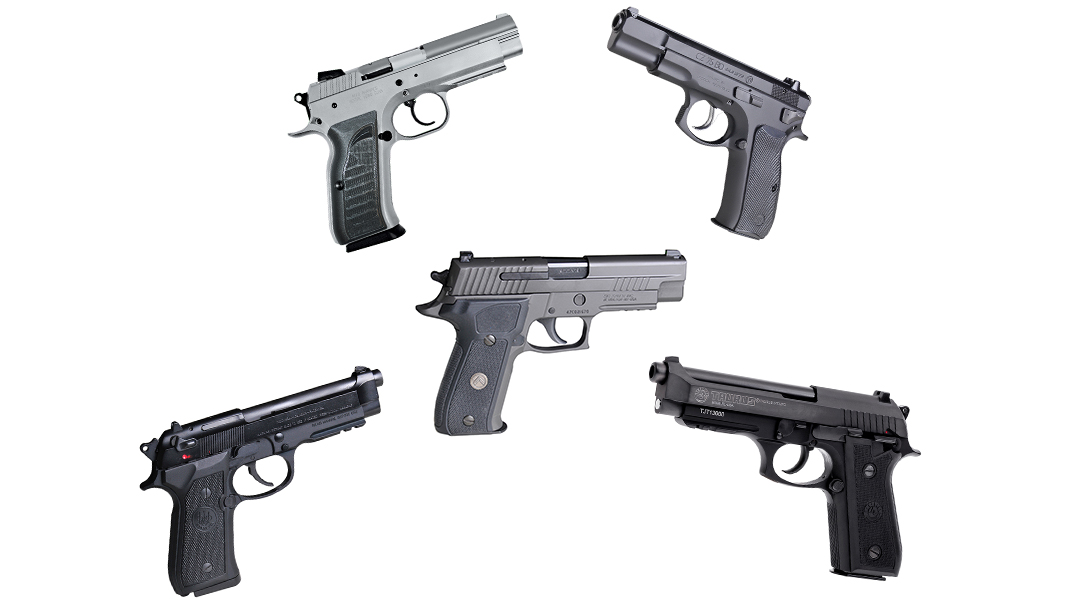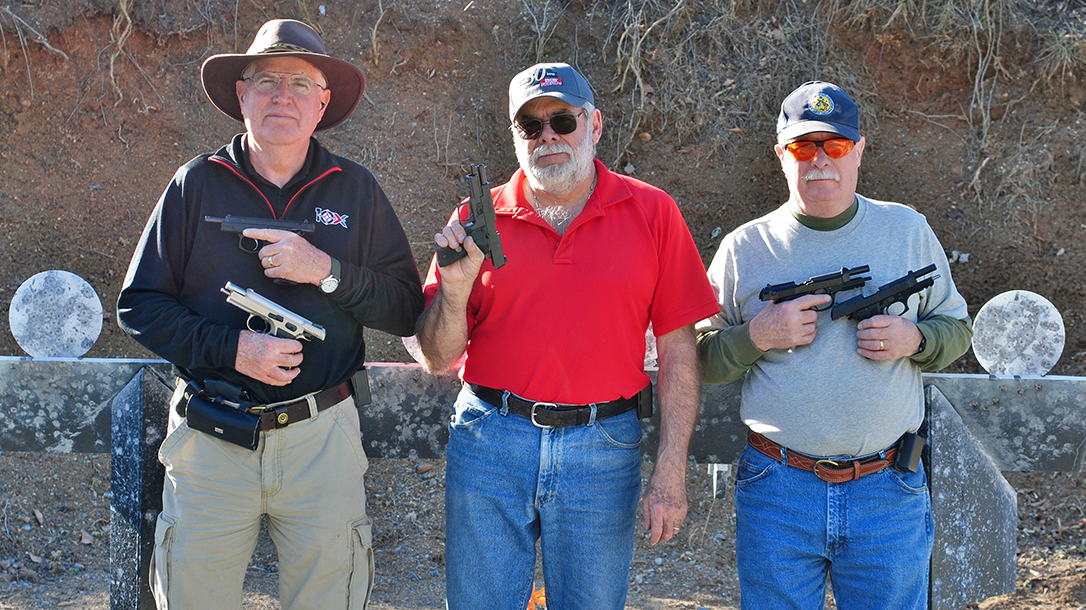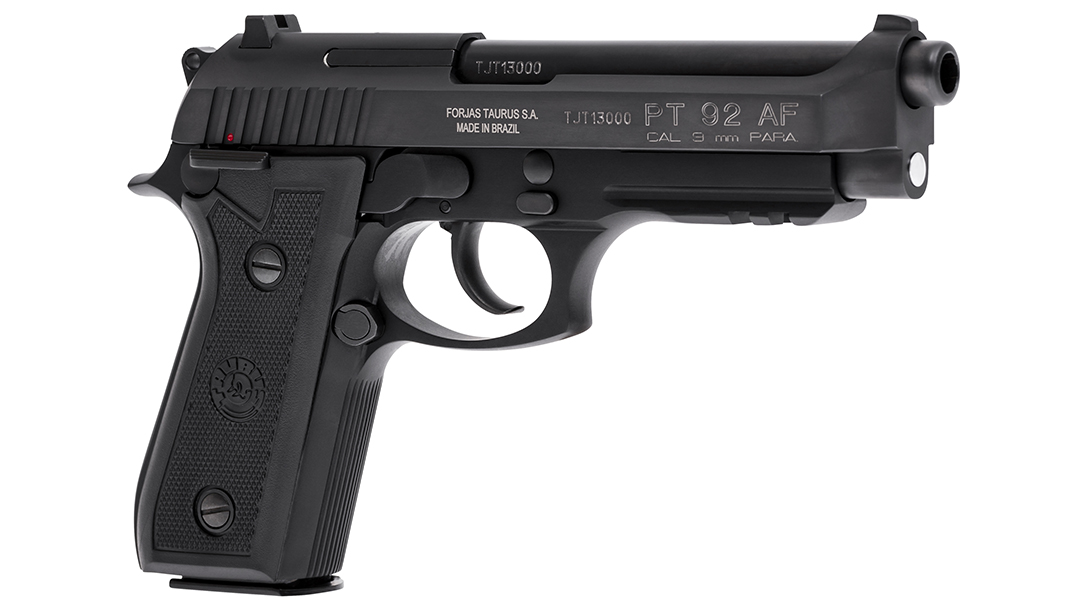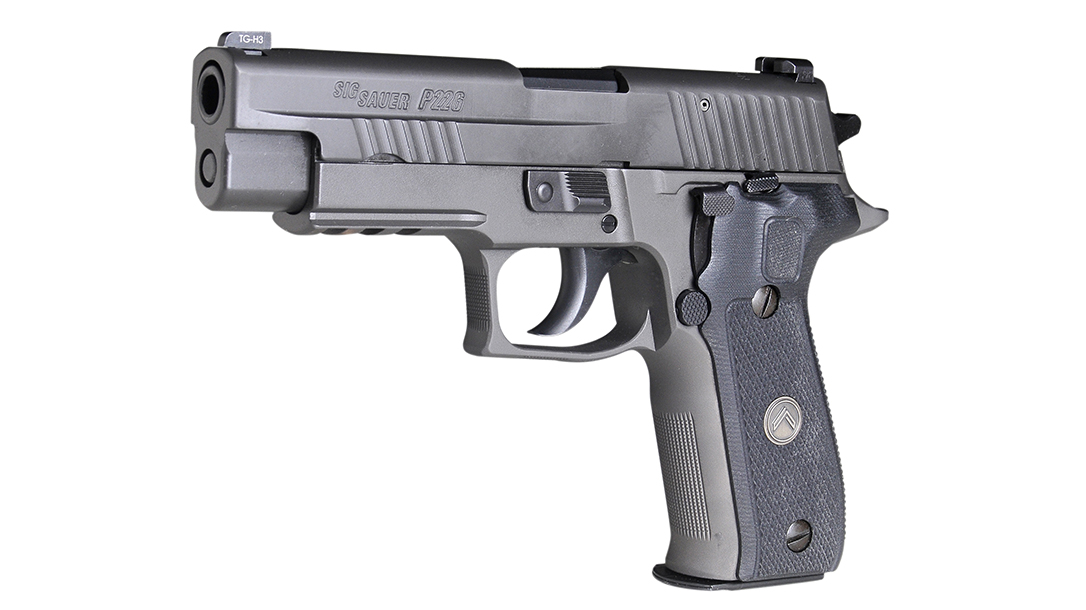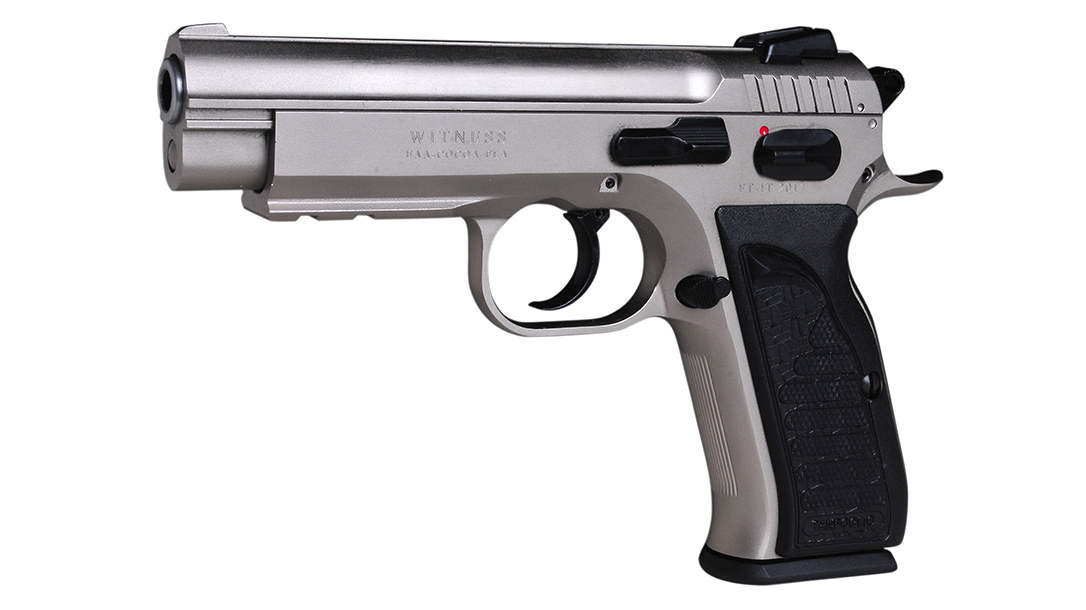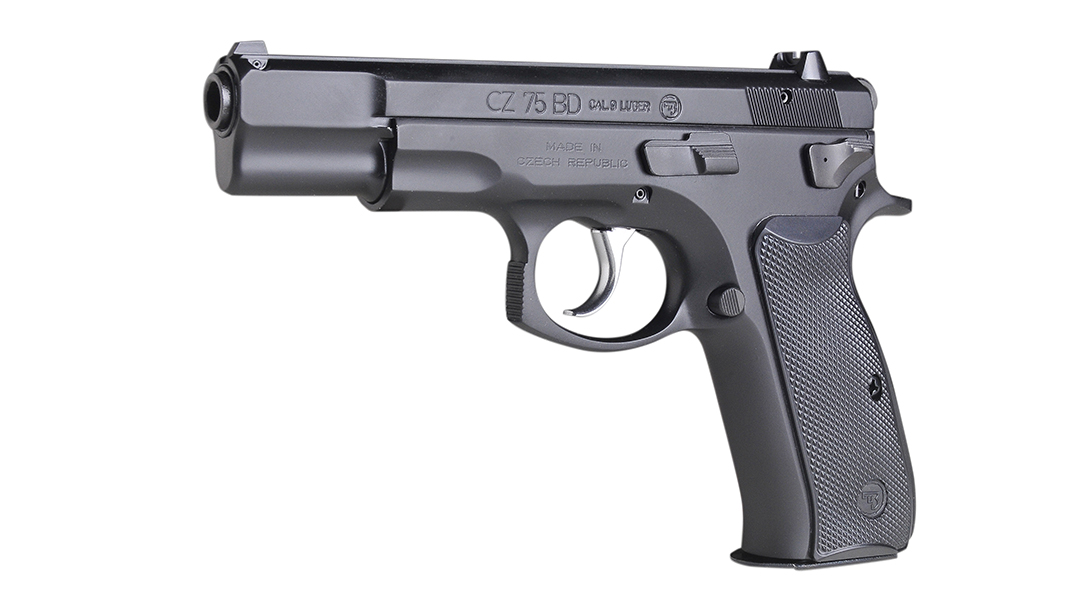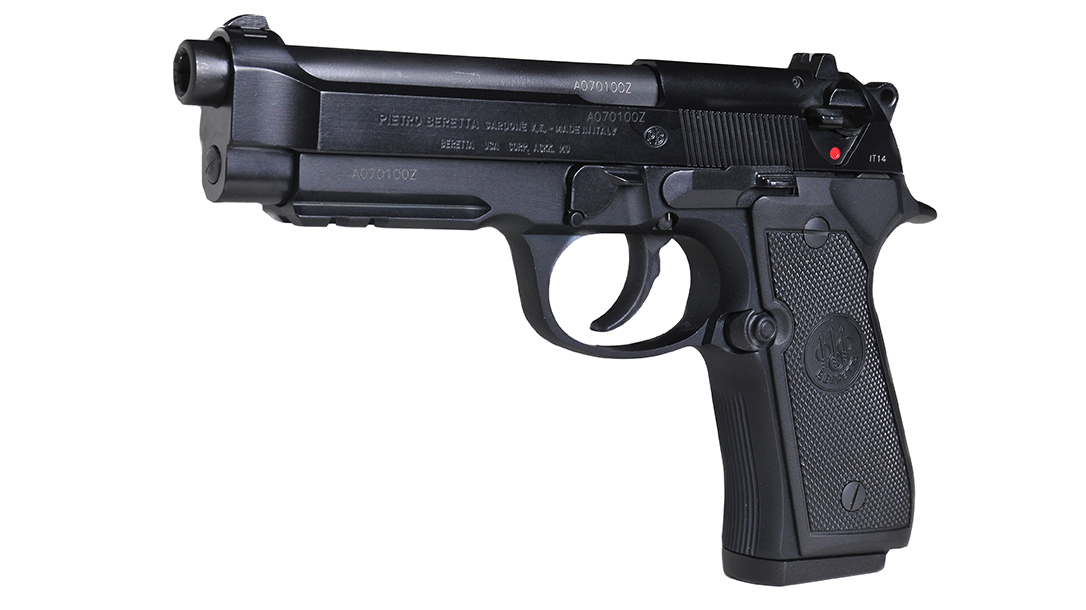Many of our younger readers will no doubt think I’m a liar when I tell them that at one time there were no polymer-framed pistols. Yes children, it’s true! Even though the first polymer-framed pistols were introduced in the 1970s, it took another decade for the “plastic” pistols to become popular.
Since their introduction in the late 19th century, most semi-auto, centerfire, service-type pistols have utilized forged-steel slides, frames and internal components. In the 1950s, Colt, S&W and Walther introduced pistols with aluminum alloy frames. The use of aluminum reduced weight while providing enhanced resistance to moisture, salts and corrosion. By the 1960s, more and more handgun manufacturers were offering their products with aluminum.
Advertisement — Continue Reading Below
While the Browning Hi-Power pistol introduced a 13-round magazine in 1935, the concept of high-capacity magazines was slow to catch on. However, by the 1970s, attitudes had changed, and high-capacity designs like the S&W Model 59, Beretta 92 and CZ 75 became the top choices of armies and law enforcement agencies around the world.
The 1980s saw the introduction of the Glock 17, whose frame and internal components were made from polymer. While originally viewed with suspicion, it became the driving force behind the “Polymer Revolution.” Today, polymer-framed pistols dominate the police and military markets. Despite this proliferation of “plastic” pistols, traditional all-metal, service-type pistols are still very much in demand.
Meet the Combatants
While discussing future “Battle Royales” with my editor, I mentioned that polymer pistols seemed to be getting all the ink in today’s firearms media and suggested that we compare several all-metal, service-type pistols. He readily agreed, and in a few weeks, I received the Beretta 92A1, CZ 75 BD, European American Armory (EAA) Witness Steel Full Size, Sig Sauer P226 Legion and a Taurus PT-92.
Advertisement — Continue Reading Below
The Beretta 92 is the standard handgun of dozens of armies and police forces around the world, including the U.S., Italy, South Africa, Brazil, France, Japan and Indonesia. Sig’s P226 is another worldwide favorite with soldiers, police and civilian shooters, and some current users include the U.S. Coast Guard, U.S. Navy SEALs, U.S. Secret Service, U.S. State Department Security and the UK’s Royal Marine Commandos.
The Brazilian-made Taurus PT-92 is a modified version of the original Beretta 92 and has seen police and military service in a number of Latin American, Asian and Middle Eastern countries. The CZ 75BD is an improved version of the Czech CZ 75 pistol. While Cold-War-era politics resulted in CZ pistols being latecomers to the U.S. market, they have been popular with police in Central Europe, the Balkans, the Middle East and Africa.
The EAA Witness Full Steel is made in Italy by Tanfoglio and is a variant of the CZ 75. It is an all-stainless-steel pistol with a double-action/single-action (DA/SA) trigger system and a single-sided safety. These guns have seen service with Middle Eastern police agencies and are extremely popular with action pistol competitors around the world.
Advertisement — Continue Reading Below
Characteristics of the Metal Handguns
All of these pistols share certain characteristics. First, they are all recoil-operated, hammer-fired, locked-breech designs. The CZ and EAA are all steel (stainless in the case of the latter), which will gladden the hearts of the traditionalists, while the Sig, Taurus and Beretta all feature steel slides and aluminum alloy frames.
All five also have DA/SA trigger mechanisms, but they operate in four different modes. The Sig uses a lever on the left side of the frame to safely drop the hammer on a loaded chamber. The Beretta has ambidextrous levers on the slide that drop the hammer and, if left down, act as safeties, preventing the pistol from being fired. On the Taurus, ambidextrous, frame-mounted thumb safeties can be applied to carry the pistol in Condition One, or can be depressed past the “fire” position to safely lower the hammer.
Advertisement — Continue Reading Below
The EAA’s safety can be left up for Condition One carry, or the hammer can be manually lowered for a DA first shot. The CZ has a frame-mounted hammer-drop lever that automatically moves up to the “fire” position after the hammer drops.
As for the rest of the controls, all five pistols have their magazine release and slide stop levers in the “proper” positions, while the magazine releases on the Beretta and Taurus can be reversed for southpaws. Both the Beretta and Sig have loaded-chamber indicators while the Taurus was the only one fitted with a key-operated internal security lock. The Sig, Beretta, Taurus and EAA all have accessory rails for mounting tactical devices.
In terms of capacity, the Sig holds 15+1 rounds while the CZ holds 16+1 and the Beretta, EAA and Taurus pistols each hold 17+1 rounds. Lastly, all five pistols were chambered for the 9mm, which just so happens to be my favorite pistol cartridge.
Advertisement — Continue Reading Below
Rules of the Ring
I test-fired each pistol for accuracy by firing three 5-shot groups from an MTM K-Zone rest at 15 yards. All five shot to the point of aim and produced groups ranging from 2 to 3 inches, which I feel is more than adequate for service-type pistols. I then disassembled, cleaned and lubricated each pistol—the only maintenance they received for the remainder of the testing. If one of them failed to work, we would attempt to correct the problem at the range and continue firing.
It took little convincing to get my friends Richard Cole and Dick Jones, both avid competitive shooters and CCW permit holders, to assist me in running these pistols through their paces. As in previous “Battle Royales,” we evaluated the pistols in seven areas: ergonomics, recoil control, sights, off-hand accuracy, reloading ease, reliability and DA trigger control. We felt these categories would give each of us a good overall feel for these “real steel” pistols.
Drilling the Metal Handguns
After a bit of discussion (“Hell, shooting cardboard targets is getting boring!”) we decided to run our five test guns through some timed drills on steel targets.
Advertisement — Continue Reading Below
Steel Plate Drill
On the signal, the shooter engages a rack of six plates 8 yards from the shooting line. They then reload the pistol and repeat the drill three more times. Scoring included the total time for each of the four runs plus a five-second penalty for any plate left standing.
| Paul | Richard | Dick | |
| Beretta | 4.71 | 7.60 | 9.15 |
| CZ | 5.14 | 5.92 | 5.62 |
| EAA | 4.70 | 6.46 | 5.90 |
| Sig | 4.63 | 5.83 | 7.45 |
| Taurus | 5.10 | 7.03 | 5.65 |
Steel Target/Popper Drill
On the signal, the shooter engages five steel plates and a Birchwood Casey self-setting popper in the center from 16 yards, double tapping each target before shooting the popper down to stop the clock. The pistol is reloaded and the drill is repeated from 12 and 8 yards, respectively. Scoring included the total time for each of the three runs plus a five-second penalty for any misses.
| Paul | Richard | Dick | |
| Beretta | 9.25 | 10.68 | 9.61 |
| CZ | 9.18 | 8.98 | 9.82 |
| EAA | 8.40 | 10.17 | 8.00 |
| Sig | 11.03 | 10.26 | 10.67 |
| Taurus | 9.86 | 10.04 | 9.74 |
Accuracy Drill
On the signal, the shooter double-taps two steel targets at 25 yards, performs a combat reload and reengages them. The drill is then run three times more. Scoring includes the total time for each of the four runs plus a five-second penalty for any misses.
Advertisement — Continue Reading Below
| Paul | Richard | Dick | |
| Beretta | 10.55 | 14.03 | 13.42 |
| CZ | 11.53 | 14.09 | 10.90 |
| EAA | 9.53 | 12.29 | 12.56 |
| Sig | 9.62 | 12.40 | 11.70 |
| Taurus | 12.91 | 13.00 | 11.71 |
In the end, each shooter would fire a minimum of 89 rounds from each pistol for a total of at least 445 rounds from all five guns. The runs with each pistol would be averaged for a final score.
All of the drills began with the shooter holding the pistol in a low-ready position and the first shot in each string of fire was from DA mode. Black Hills Ammunition kindly provided enough 115-grain FMJs for our needs. Brownells also provided an Uplula magazine loader to make our lives easier. One of us would fire the pistol, the second ran the timer and the third kept score while my wife, Becky, served as photographer. We began shooting at 11 a.m. and, except for a short break for lunch, continued to send projectiles downrange until 3 p.m., expending in excess of 1,400 rounds.
9mm Metal Handguns In-Depth Results
| Beretta 92A1 | CZ 75 BD | EAA Witness Steel | Sig Sauer P226 Legion | Taurus PT-92 | |
|---|---|---|---|---|---|
| Reliability | 15 | 15 | 15 | 15 | 8 |
| Ergonomics | 11 | 14 | 14 | 13 | 10 |
| Trigger Control | 11 | 12 | 12 | 8 | 9 |
| Recoil Control | 13 | 15 | 14 | 13 | 11 |
| Sights | 11 | 10 | 11 | 14 | 7 |
| Off-Hand Accuracy | 12 | 12 | 12 | 12 | 9 |
| Reloading Ease | 11 | 10 | 7 | 10 | 10 |
| TOTAL | 84 | 88 | 85 | 85 | 64 |
Note: 15 is a perfect score for each category while 105 is a perfect total score
Advertisement — Continue Reading Below
Using a calculator, Becky totaled and averaged our times. Each of us then graded the pistols in the seven categories using a 1 (worst) to 5 (best) point system, with 15 being a perfect score. Here I’ll offer some explanation that should be helpful.
Reliability
Four of the test pistols ran flawlessly, but we experienced two stovepipe jams and two double-feeds with the Taurus. We were unable to ascertain if this was the result of a faulty magazine or not.
Ergonomics
This was very subjective call, as one shooter had smaller hands and found the frame-mounted decocking levers/safeties difficult to manipulate, while another did not like the shape of the grip frames on the Beretta and Taurus. We all liked the ergonomics of the EAA and CZ, although one shooter found the EAA’s slide difficult to rack and thought more aggressive grasping grooves would be a plus.
Trigger Control
The three of us found the DA trigger strokes on all five pistols, especially the Sig, rather long, heavy and/or gritty. One complained that the smooth, polished trigger on the CZ let his trigger finger slide past the first joint, causing the trigger to pinch his finger at the end of the stroke.
Recoil Control
Here the EAA and CZ scored highly while the Sig’s textured grips panels and checkered front- and backstraps allowed for a very secure purchase.
Sights
We felt the sights on four of the five pistols were rather small and/or low. The EAA’s red-dot front sight garnered some praise while the Sig’s easy-to-see X-Ray sights were admired by all. About halfway through the shooting, the white-dot insert in the Taurus’ front sight fell out, which resulted in its low score.
Off-Hand Accuracy
This was a four-way tie that, we all believed, would have been a five-way tie if the Taurus’ front sight insert had not fallen out.
Reloading Ease
It was unanimous that all five pistols would benefit from longer magazine release buttons. As the pistols got dirtier, the EAA’s magazines would sometimes fail to fall free and had to be manually pulled from the grip.
Picking a Favorite Among the Metal Handguns
As I usually do, I queried my fellow shooters as to their favorites of our test pistols, and why. Dick Jones picked the CZ 75 DB, saying, “I really liked this pistol. It just felt good in my hand, pointed very naturally and I liked the DA trigger pull.”
Richard Cole picked the EAA as his favorite. He said, “It had better balance than the others with very controllable recoil and a great grip.”
My pick was the Beretta 92A1. Why? Because I find the Beretta’s grip to be one of the most ergonomically pleasing of any pistol. It just feels right in my hand, allowing fast, accurate shooting. Well, there you have it. As my old high school math teacher used to tell us, “The numbers don’t lie!”
Metal Handguns: Specs
Beretta 92A1
- Caliber: 9mm
- Barrel: 4.9 inches
- OA Length: 8.5 inches
- Weight: 33.3 ounces (empty)
- Grips: Polymer
- Sights: Three-dot
- Action: DA/SA
- Finish: Matte black
- Capacity: 17+1
- MSRP: $775
CZ 75 BD
- Caliber: 9mm
- Barrel: 4.6 inches
- OA Length: 8.1 inches
- Weight: 35.3 ounces (empty)
- Grips: Polymer
- Sights: Three-dot
- Action: DA/SA
- Finish: Matte black
- Capacity: 16+1
- MSRP: $612
EAA Witness Steel
- Caliber: 9mm
- Barrel: 4.5 inches
- OA Length: 8.1 inches
- Weight: 33 ounces (empty)
- Grips: Polymer
- Sights: Three-dot
- Action: DA/SA
- Finish: Wonder
- Capacity: 17+1
- MSRP: $699
Sig Sauer P226 Legion
- Caliber: 9mm
- Barrel: 4.4 inches
- OA Length: 8 inches
- Weight: 34 ounces (empty)
- Grips: G10
- Sights: X-Ray day/night
- Action: DA/SA
- Finish: Legion gray PVD
- Capacity: 15+1
- MSRP: $1,413
Taurus PT-92
- Caliber: 9mm
- Barrel: 5 inches
- OA Length: 8.5 inches
- Weight: 34 ounces (empty)
- Grips: Polymer
- Sights: Three-dot
- Action: DA/SA
- Finish: Matte black
- Capacity: 17+1
- MSRP: $498
For more information about these metal handguns, please visit beretta.com, cz-usa.com, eaacorp.com, sigsauer.com and taurususa.com.
This article is from the May/June 2018 issue of “Combat Handguns” magazine. Grab your copy at OutdoorGroupStore.com.
